Economics Assignment 1: Analysis of Market Structures and Efficiency
VerifiedAdded on 2020/05/28
|23
|4439
|118
Report
AI Summary
This economics assignment provides a comprehensive analysis of different market structures, focusing on perfect competition, monopolistically competitive markets, and oligopolies, with specific examples from the Australian economy. The assignment begins by differentiating between perfectly competitive and monopolistically competitive markets, highlighting key characteristics such as product type, number of players, and market power. It then delves into the equilibrium conditions in both market types, examining short-run and long-run scenarios, and illustrating these concepts with diagrams. The report further explores allocative and productive efficiencies in these markets. A significant portion of the assignment is dedicated to the oligopolistic market structure, discussing its features and providing examples of its presence in the Australian economy. The assignment concludes by examining the crisis of housing affordability in Australia, offering insights into its economic implications. Overall, the assignment offers a detailed and insightful exploration of market structures and their relevance in real-world economic scenarios.
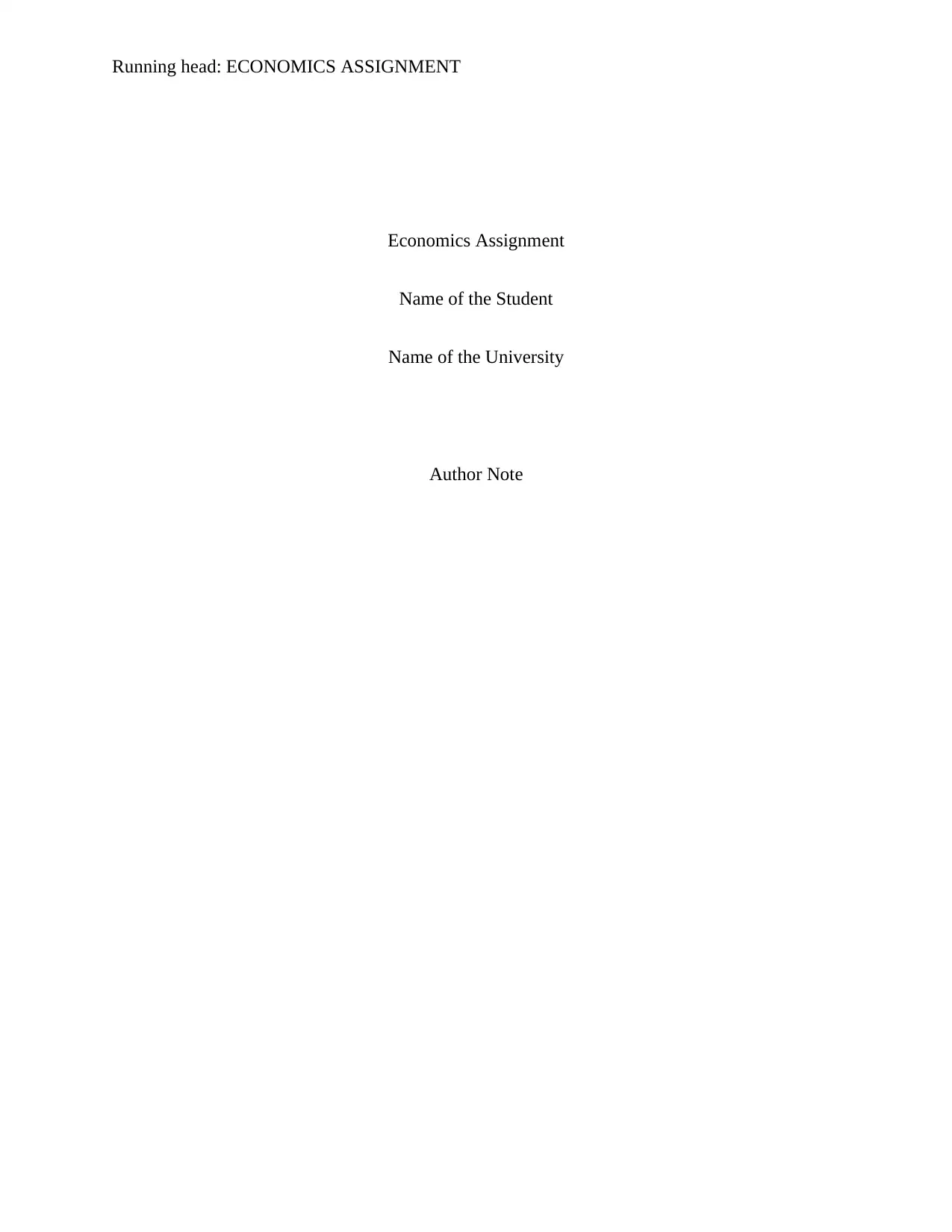
Running head: ECONOMICS ASSIGNMENT
Economics Assignment
Name of the Student
Name of the University
Author Note
Economics Assignment
Name of the Student
Name of the University
Author Note
Paraphrase This Document
Need a fresh take? Get an instant paraphrase of this document with our AI Paraphraser
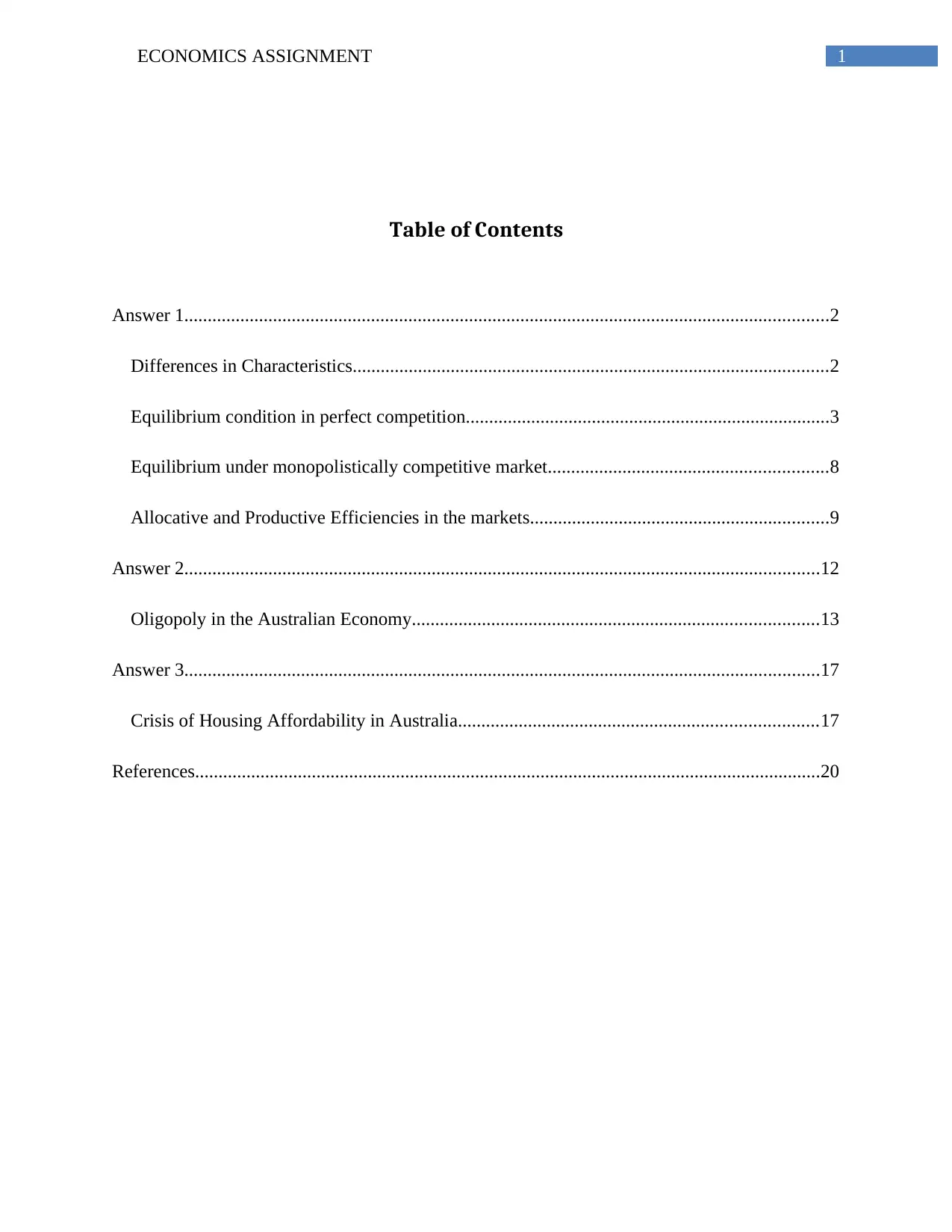
1ECONOMICS ASSIGNMENT
Table of Contents
Answer 1..........................................................................................................................................2
Differences in Characteristics......................................................................................................2
Equilibrium condition in perfect competition..............................................................................3
Equilibrium under monopolistically competitive market............................................................8
Allocative and Productive Efficiencies in the markets................................................................9
Answer 2........................................................................................................................................12
Oligopoly in the Australian Economy.......................................................................................13
Answer 3........................................................................................................................................17
Crisis of Housing Affordability in Australia.............................................................................17
References......................................................................................................................................20
Table of Contents
Answer 1..........................................................................................................................................2
Differences in Characteristics......................................................................................................2
Equilibrium condition in perfect competition..............................................................................3
Equilibrium under monopolistically competitive market............................................................8
Allocative and Productive Efficiencies in the markets................................................................9
Answer 2........................................................................................................................................12
Oligopoly in the Australian Economy.......................................................................................13
Answer 3........................................................................................................................................17
Crisis of Housing Affordability in Australia.............................................................................17
References......................................................................................................................................20
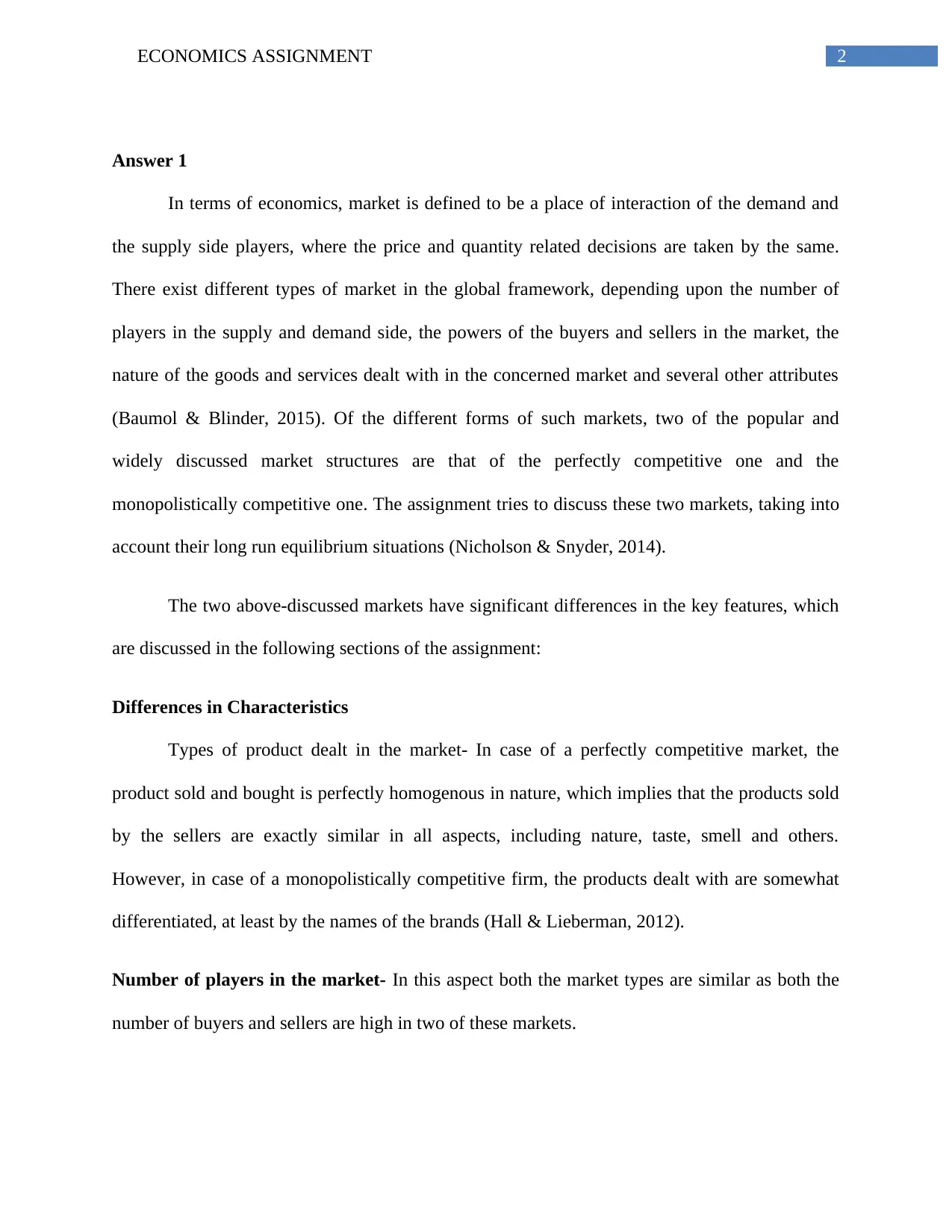
2ECONOMICS ASSIGNMENT
Answer 1
In terms of economics, market is defined to be a place of interaction of the demand and
the supply side players, where the price and quantity related decisions are taken by the same.
There exist different types of market in the global framework, depending upon the number of
players in the supply and demand side, the powers of the buyers and sellers in the market, the
nature of the goods and services dealt with in the concerned market and several other attributes
(Baumol & Blinder, 2015). Of the different forms of such markets, two of the popular and
widely discussed market structures are that of the perfectly competitive one and the
monopolistically competitive one. The assignment tries to discuss these two markets, taking into
account their long run equilibrium situations (Nicholson & Snyder, 2014).
The two above-discussed markets have significant differences in the key features, which
are discussed in the following sections of the assignment:
Differences in Characteristics
Types of product dealt in the market- In case of a perfectly competitive market, the
product sold and bought is perfectly homogenous in nature, which implies that the products sold
by the sellers are exactly similar in all aspects, including nature, taste, smell and others.
However, in case of a monopolistically competitive firm, the products dealt with are somewhat
differentiated, at least by the names of the brands (Hall & Lieberman, 2012).
Number of players in the market- In this aspect both the market types are similar as both the
number of buyers and sellers are high in two of these markets.
Answer 1
In terms of economics, market is defined to be a place of interaction of the demand and
the supply side players, where the price and quantity related decisions are taken by the same.
There exist different types of market in the global framework, depending upon the number of
players in the supply and demand side, the powers of the buyers and sellers in the market, the
nature of the goods and services dealt with in the concerned market and several other attributes
(Baumol & Blinder, 2015). Of the different forms of such markets, two of the popular and
widely discussed market structures are that of the perfectly competitive one and the
monopolistically competitive one. The assignment tries to discuss these two markets, taking into
account their long run equilibrium situations (Nicholson & Snyder, 2014).
The two above-discussed markets have significant differences in the key features, which
are discussed in the following sections of the assignment:
Differences in Characteristics
Types of product dealt in the market- In case of a perfectly competitive market, the
product sold and bought is perfectly homogenous in nature, which implies that the products sold
by the sellers are exactly similar in all aspects, including nature, taste, smell and others.
However, in case of a monopolistically competitive firm, the products dealt with are somewhat
differentiated, at least by the names of the brands (Hall & Lieberman, 2012).
Number of players in the market- In this aspect both the market types are similar as both the
number of buyers and sellers are high in two of these markets.
⊘ This is a preview!⊘
Do you want full access?
Subscribe today to unlock all pages.

Trusted by 1+ million students worldwide
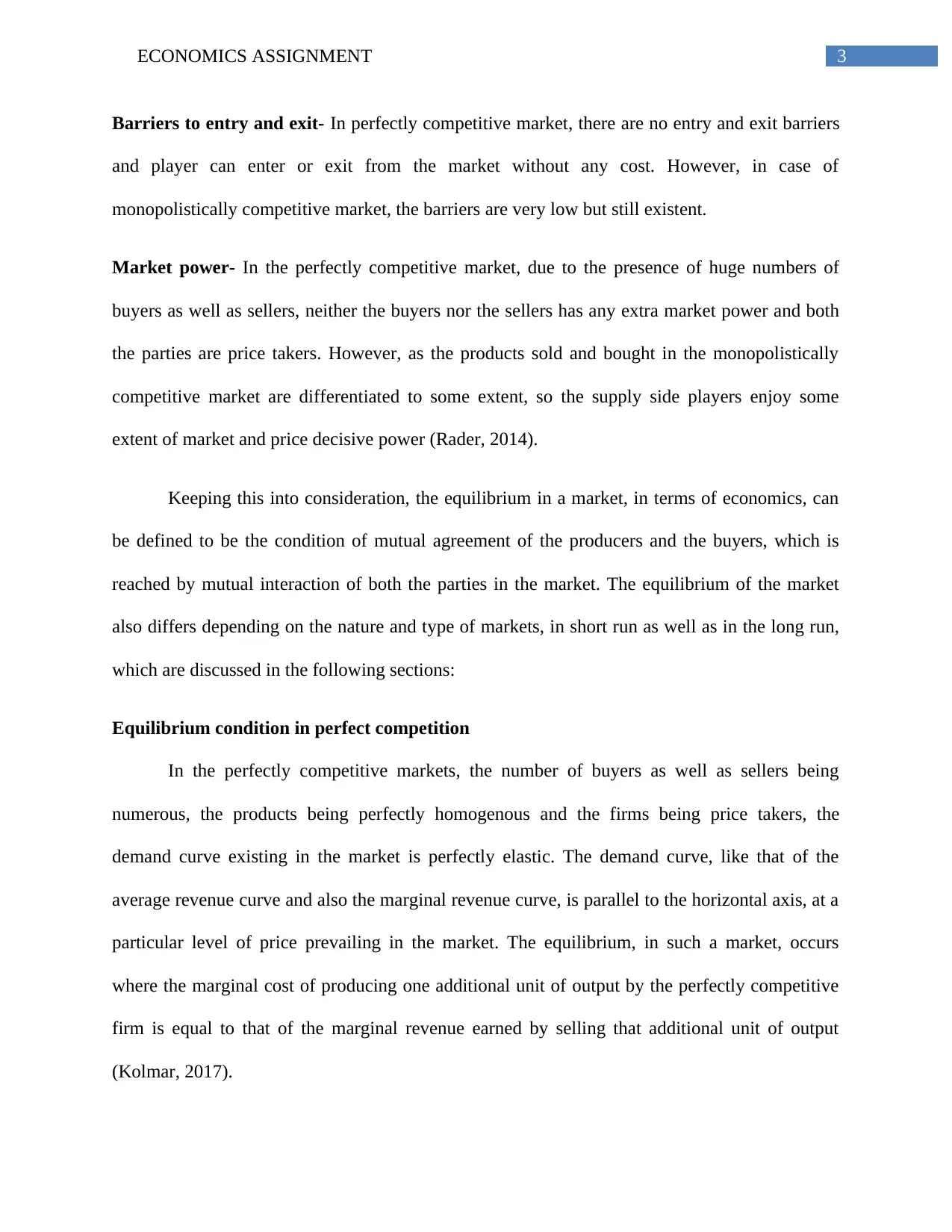
3ECONOMICS ASSIGNMENT
Barriers to entry and exit- In perfectly competitive market, there are no entry and exit barriers
and player can enter or exit from the market without any cost. However, in case of
monopolistically competitive market, the barriers are very low but still existent.
Market power- In the perfectly competitive market, due to the presence of huge numbers of
buyers as well as sellers, neither the buyers nor the sellers has any extra market power and both
the parties are price takers. However, as the products sold and bought in the monopolistically
competitive market are differentiated to some extent, so the supply side players enjoy some
extent of market and price decisive power (Rader, 2014).
Keeping this into consideration, the equilibrium in a market, in terms of economics, can
be defined to be the condition of mutual agreement of the producers and the buyers, which is
reached by mutual interaction of both the parties in the market. The equilibrium of the market
also differs depending on the nature and type of markets, in short run as well as in the long run,
which are discussed in the following sections:
Equilibrium condition in perfect competition
In the perfectly competitive markets, the number of buyers as well as sellers being
numerous, the products being perfectly homogenous and the firms being price takers, the
demand curve existing in the market is perfectly elastic. The demand curve, like that of the
average revenue curve and also the marginal revenue curve, is parallel to the horizontal axis, at a
particular level of price prevailing in the market. The equilibrium, in such a market, occurs
where the marginal cost of producing one additional unit of output by the perfectly competitive
firm is equal to that of the marginal revenue earned by selling that additional unit of output
(Kolmar, 2017).
Barriers to entry and exit- In perfectly competitive market, there are no entry and exit barriers
and player can enter or exit from the market without any cost. However, in case of
monopolistically competitive market, the barriers are very low but still existent.
Market power- In the perfectly competitive market, due to the presence of huge numbers of
buyers as well as sellers, neither the buyers nor the sellers has any extra market power and both
the parties are price takers. However, as the products sold and bought in the monopolistically
competitive market are differentiated to some extent, so the supply side players enjoy some
extent of market and price decisive power (Rader, 2014).
Keeping this into consideration, the equilibrium in a market, in terms of economics, can
be defined to be the condition of mutual agreement of the producers and the buyers, which is
reached by mutual interaction of both the parties in the market. The equilibrium of the market
also differs depending on the nature and type of markets, in short run as well as in the long run,
which are discussed in the following sections:
Equilibrium condition in perfect competition
In the perfectly competitive markets, the number of buyers as well as sellers being
numerous, the products being perfectly homogenous and the firms being price takers, the
demand curve existing in the market is perfectly elastic. The demand curve, like that of the
average revenue curve and also the marginal revenue curve, is parallel to the horizontal axis, at a
particular level of price prevailing in the market. The equilibrium, in such a market, occurs
where the marginal cost of producing one additional unit of output by the perfectly competitive
firm is equal to that of the marginal revenue earned by selling that additional unit of output
(Kolmar, 2017).
Paraphrase This Document
Need a fresh take? Get an instant paraphrase of this document with our AI Paraphraser
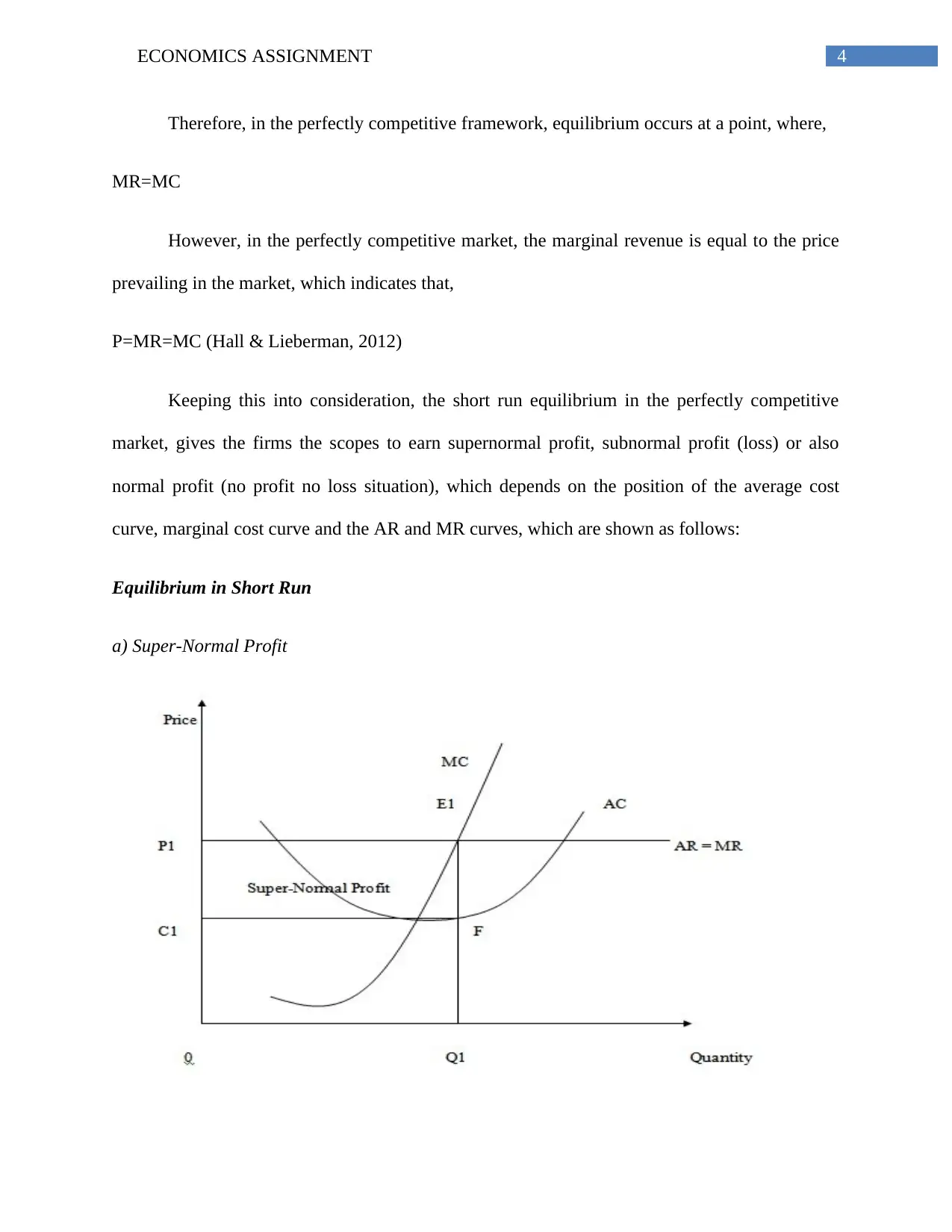
4ECONOMICS ASSIGNMENT
Therefore, in the perfectly competitive framework, equilibrium occurs at a point, where,
MR=MC
However, in the perfectly competitive market, the marginal revenue is equal to the price
prevailing in the market, which indicates that,
P=MR=MC (Hall & Lieberman, 2012)
Keeping this into consideration, the short run equilibrium in the perfectly competitive
market, gives the firms the scopes to earn supernormal profit, subnormal profit (loss) or also
normal profit (no profit no loss situation), which depends on the position of the average cost
curve, marginal cost curve and the AR and MR curves, which are shown as follows:
Equilibrium in Short Run
a) Super-Normal Profit
Therefore, in the perfectly competitive framework, equilibrium occurs at a point, where,
MR=MC
However, in the perfectly competitive market, the marginal revenue is equal to the price
prevailing in the market, which indicates that,
P=MR=MC (Hall & Lieberman, 2012)
Keeping this into consideration, the short run equilibrium in the perfectly competitive
market, gives the firms the scopes to earn supernormal profit, subnormal profit (loss) or also
normal profit (no profit no loss situation), which depends on the position of the average cost
curve, marginal cost curve and the AR and MR curves, which are shown as follows:
Equilibrium in Short Run
a) Super-Normal Profit
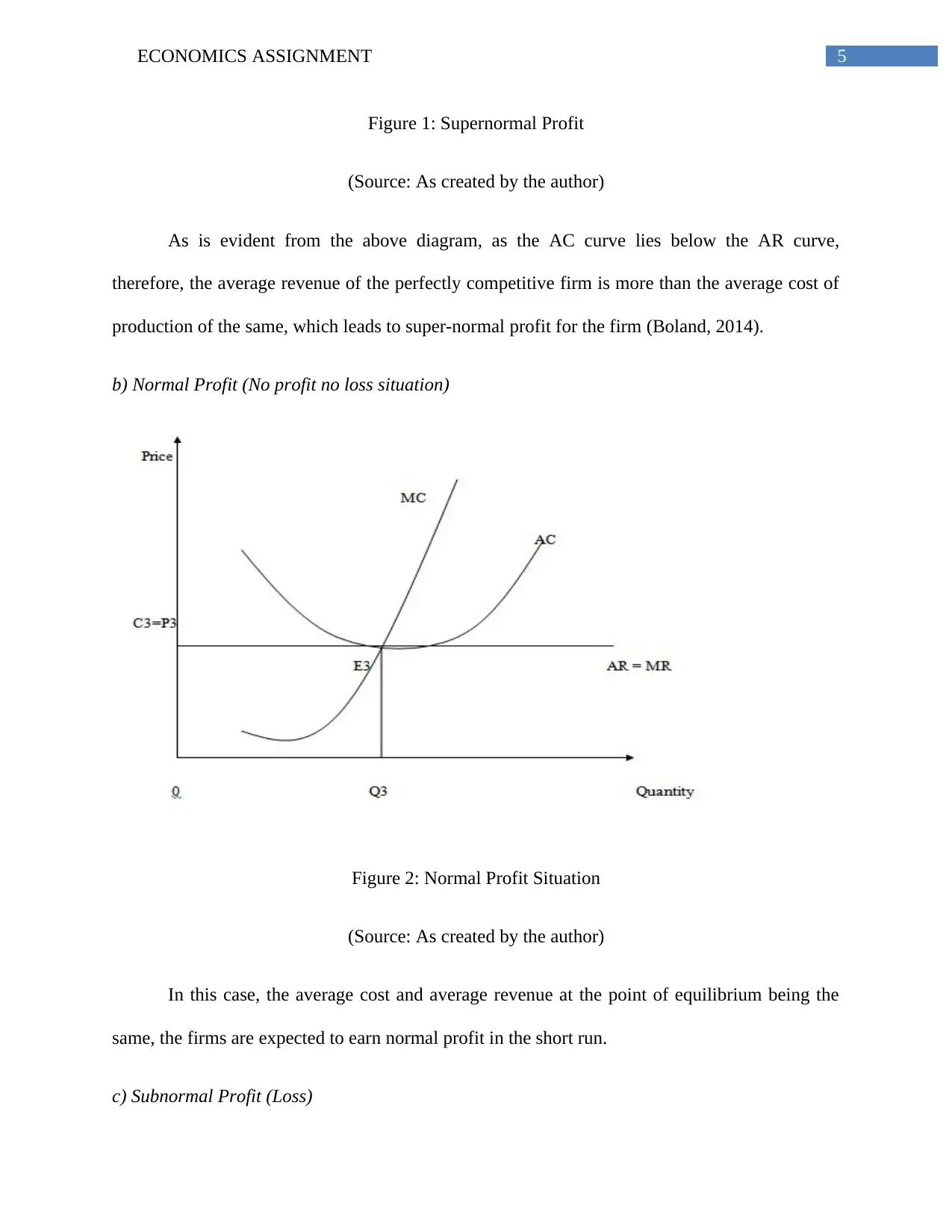
5ECONOMICS ASSIGNMENT
Figure 1: Supernormal Profit
(Source: As created by the author)
As is evident from the above diagram, as the AC curve lies below the AR curve,
therefore, the average revenue of the perfectly competitive firm is more than the average cost of
production of the same, which leads to super-normal profit for the firm (Boland, 2014).
b) Normal Profit (No profit no loss situation)
Figure 2: Normal Profit Situation
(Source: As created by the author)
In this case, the average cost and average revenue at the point of equilibrium being the
same, the firms are expected to earn normal profit in the short run.
c) Subnormal Profit (Loss)
Figure 1: Supernormal Profit
(Source: As created by the author)
As is evident from the above diagram, as the AC curve lies below the AR curve,
therefore, the average revenue of the perfectly competitive firm is more than the average cost of
production of the same, which leads to super-normal profit for the firm (Boland, 2014).
b) Normal Profit (No profit no loss situation)
Figure 2: Normal Profit Situation
(Source: As created by the author)
In this case, the average cost and average revenue at the point of equilibrium being the
same, the firms are expected to earn normal profit in the short run.
c) Subnormal Profit (Loss)
⊘ This is a preview!⊘
Do you want full access?
Subscribe today to unlock all pages.

Trusted by 1+ million students worldwide
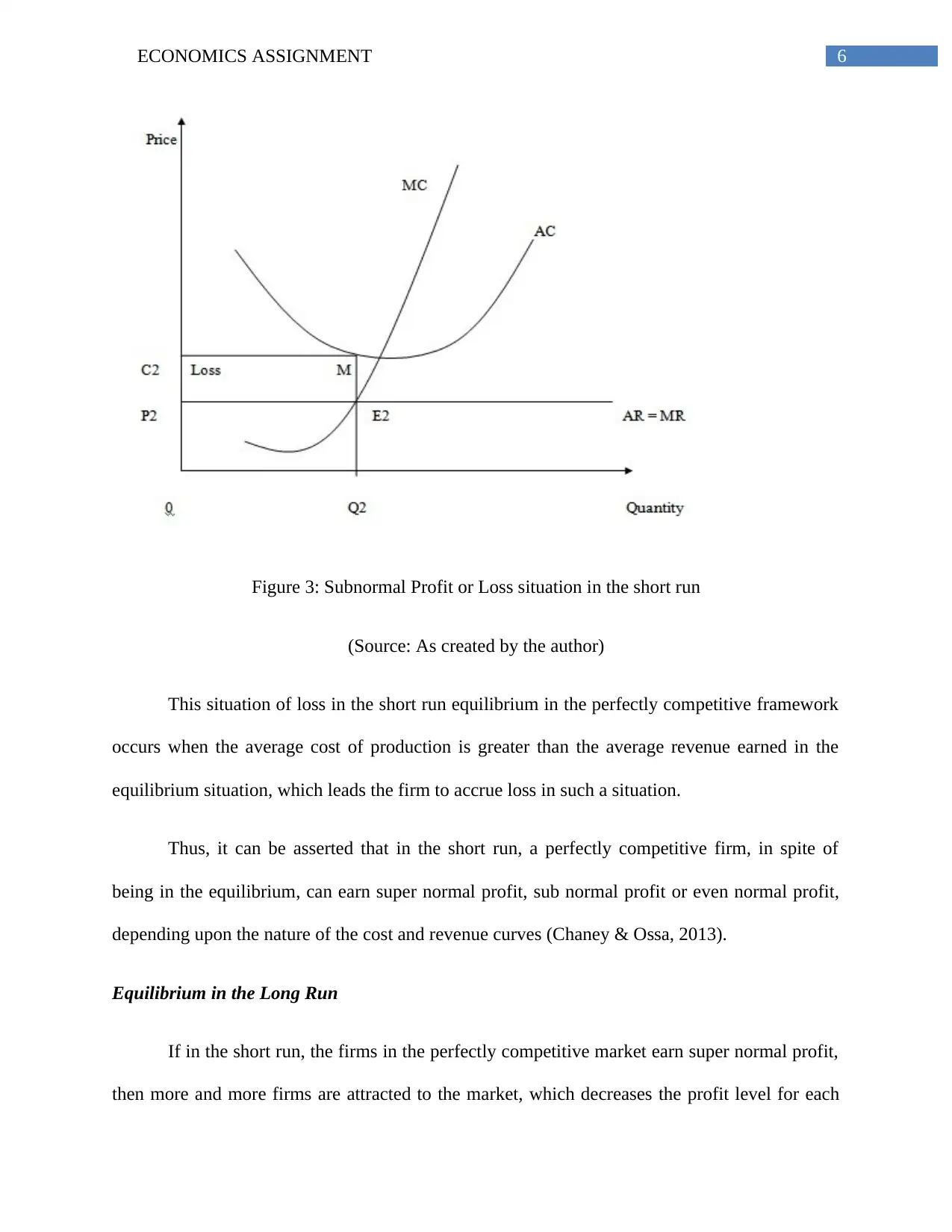
6ECONOMICS ASSIGNMENT
Figure 3: Subnormal Profit or Loss situation in the short run
(Source: As created by the author)
This situation of loss in the short run equilibrium in the perfectly competitive framework
occurs when the average cost of production is greater than the average revenue earned in the
equilibrium situation, which leads the firm to accrue loss in such a situation.
Thus, it can be asserted that in the short run, a perfectly competitive firm, in spite of
being in the equilibrium, can earn super normal profit, sub normal profit or even normal profit,
depending upon the nature of the cost and revenue curves (Chaney & Ossa, 2013).
Equilibrium in the Long Run
If in the short run, the firms in the perfectly competitive market earn super normal profit,
then more and more firms are attracted to the market, which decreases the profit level for each
Figure 3: Subnormal Profit or Loss situation in the short run
(Source: As created by the author)
This situation of loss in the short run equilibrium in the perfectly competitive framework
occurs when the average cost of production is greater than the average revenue earned in the
equilibrium situation, which leads the firm to accrue loss in such a situation.
Thus, it can be asserted that in the short run, a perfectly competitive firm, in spite of
being in the equilibrium, can earn super normal profit, sub normal profit or even normal profit,
depending upon the nature of the cost and revenue curves (Chaney & Ossa, 2013).
Equilibrium in the Long Run
If in the short run, the firms in the perfectly competitive market earn super normal profit,
then more and more firms are attracted to the market, which decreases the profit level for each
Paraphrase This Document
Need a fresh take? Get an instant paraphrase of this document with our AI Paraphraser
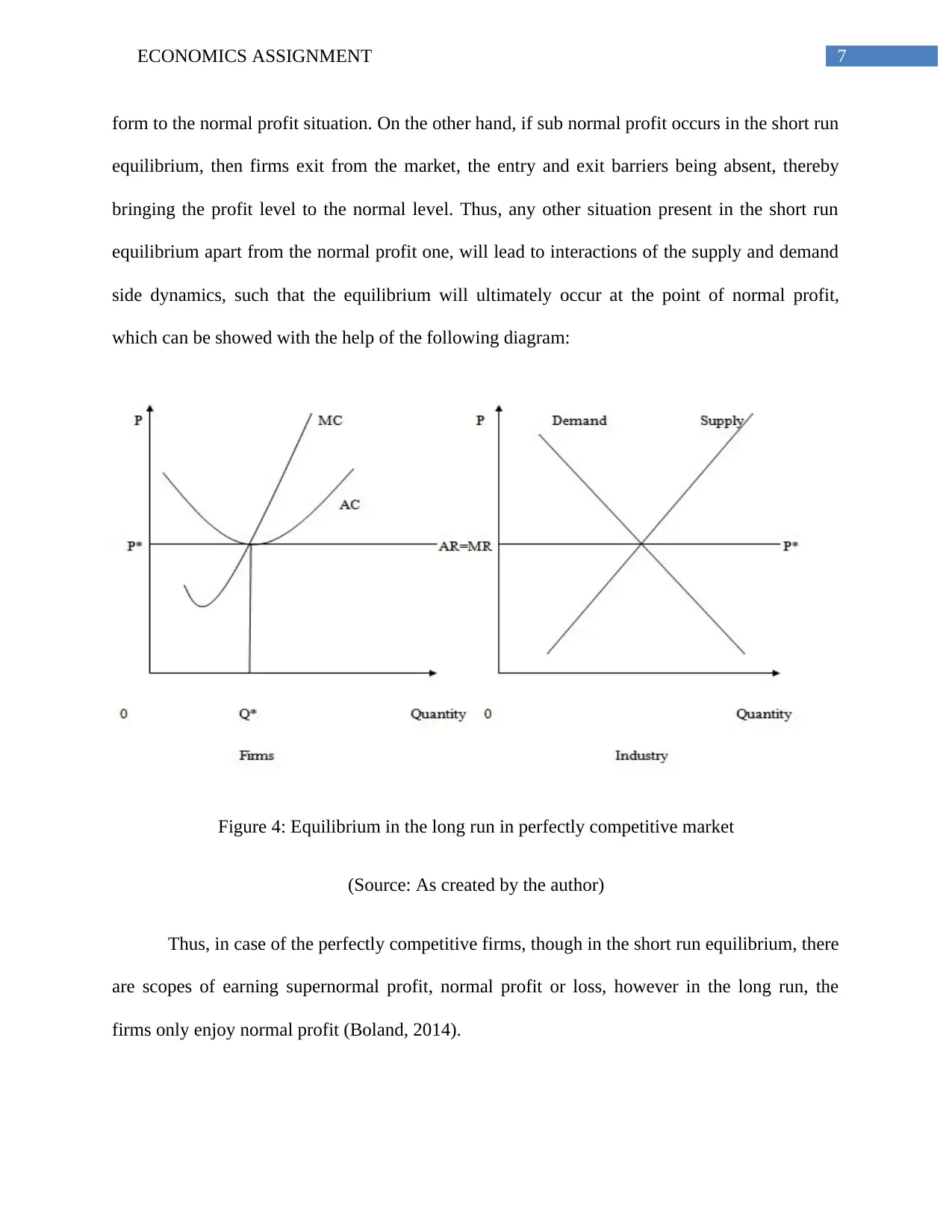
7ECONOMICS ASSIGNMENT
form to the normal profit situation. On the other hand, if sub normal profit occurs in the short run
equilibrium, then firms exit from the market, the entry and exit barriers being absent, thereby
bringing the profit level to the normal level. Thus, any other situation present in the short run
equilibrium apart from the normal profit one, will lead to interactions of the supply and demand
side dynamics, such that the equilibrium will ultimately occur at the point of normal profit,
which can be showed with the help of the following diagram:
Figure 4: Equilibrium in the long run in perfectly competitive market
(Source: As created by the author)
Thus, in case of the perfectly competitive firms, though in the short run equilibrium, there
are scopes of earning supernormal profit, normal profit or loss, however in the long run, the
firms only enjoy normal profit (Boland, 2014).
form to the normal profit situation. On the other hand, if sub normal profit occurs in the short run
equilibrium, then firms exit from the market, the entry and exit barriers being absent, thereby
bringing the profit level to the normal level. Thus, any other situation present in the short run
equilibrium apart from the normal profit one, will lead to interactions of the supply and demand
side dynamics, such that the equilibrium will ultimately occur at the point of normal profit,
which can be showed with the help of the following diagram:
Figure 4: Equilibrium in the long run in perfectly competitive market
(Source: As created by the author)
Thus, in case of the perfectly competitive firms, though in the short run equilibrium, there
are scopes of earning supernormal profit, normal profit or loss, however in the long run, the
firms only enjoy normal profit (Boland, 2014).
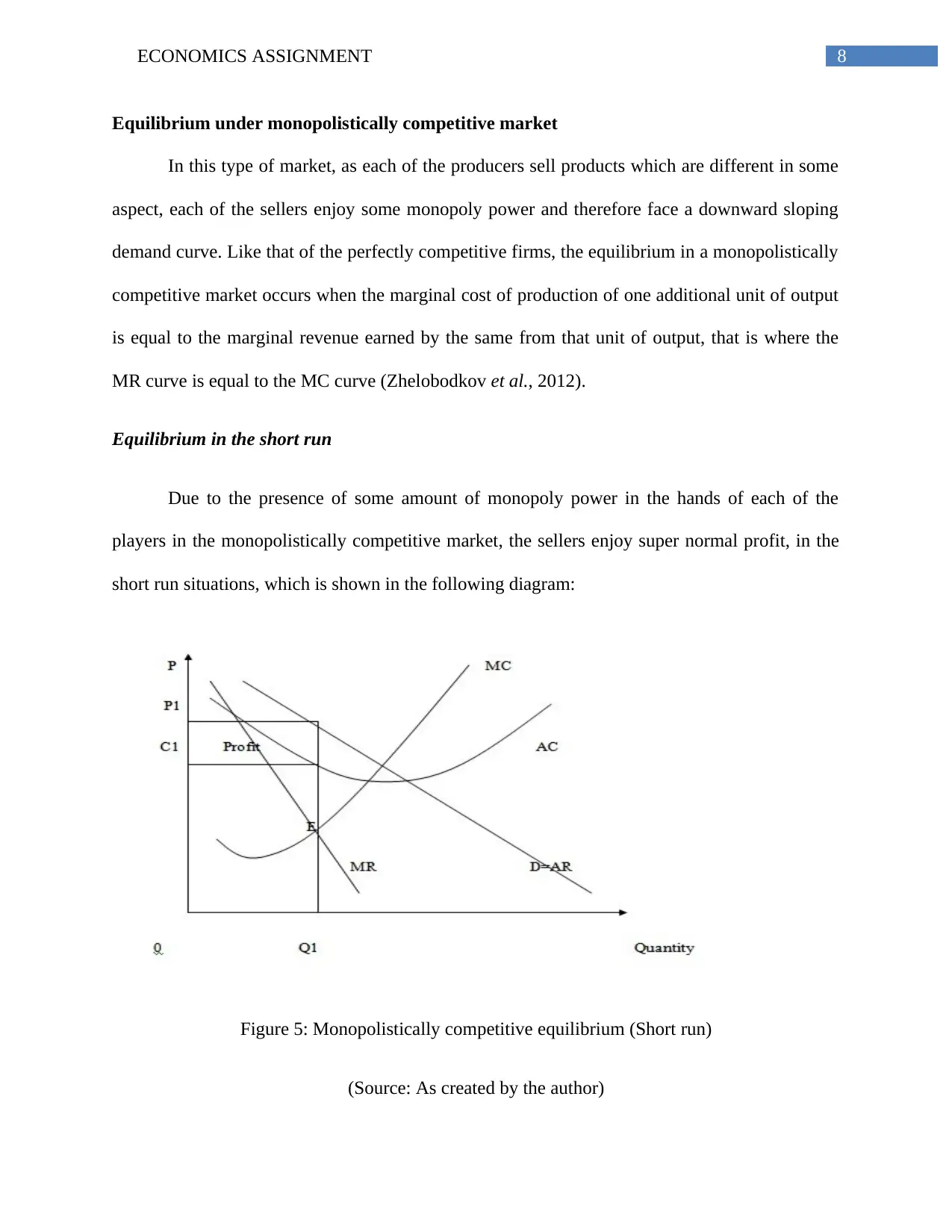
8ECONOMICS ASSIGNMENT
Equilibrium under monopolistically competitive market
In this type of market, as each of the producers sell products which are different in some
aspect, each of the sellers enjoy some monopoly power and therefore face a downward sloping
demand curve. Like that of the perfectly competitive firms, the equilibrium in a monopolistically
competitive market occurs when the marginal cost of production of one additional unit of output
is equal to the marginal revenue earned by the same from that unit of output, that is where the
MR curve is equal to the MC curve (Zhelobodkov et al., 2012).
Equilibrium in the short run
Due to the presence of some amount of monopoly power in the hands of each of the
players in the monopolistically competitive market, the sellers enjoy super normal profit, in the
short run situations, which is shown in the following diagram:
Figure 5: Monopolistically competitive equilibrium (Short run)
(Source: As created by the author)
Equilibrium under monopolistically competitive market
In this type of market, as each of the producers sell products which are different in some
aspect, each of the sellers enjoy some monopoly power and therefore face a downward sloping
demand curve. Like that of the perfectly competitive firms, the equilibrium in a monopolistically
competitive market occurs when the marginal cost of production of one additional unit of output
is equal to the marginal revenue earned by the same from that unit of output, that is where the
MR curve is equal to the MC curve (Zhelobodkov et al., 2012).
Equilibrium in the short run
Due to the presence of some amount of monopoly power in the hands of each of the
players in the monopolistically competitive market, the sellers enjoy super normal profit, in the
short run situations, which is shown in the following diagram:
Figure 5: Monopolistically competitive equilibrium (Short run)
(Source: As created by the author)
⊘ This is a preview!⊘
Do you want full access?
Subscribe today to unlock all pages.

Trusted by 1+ million students worldwide
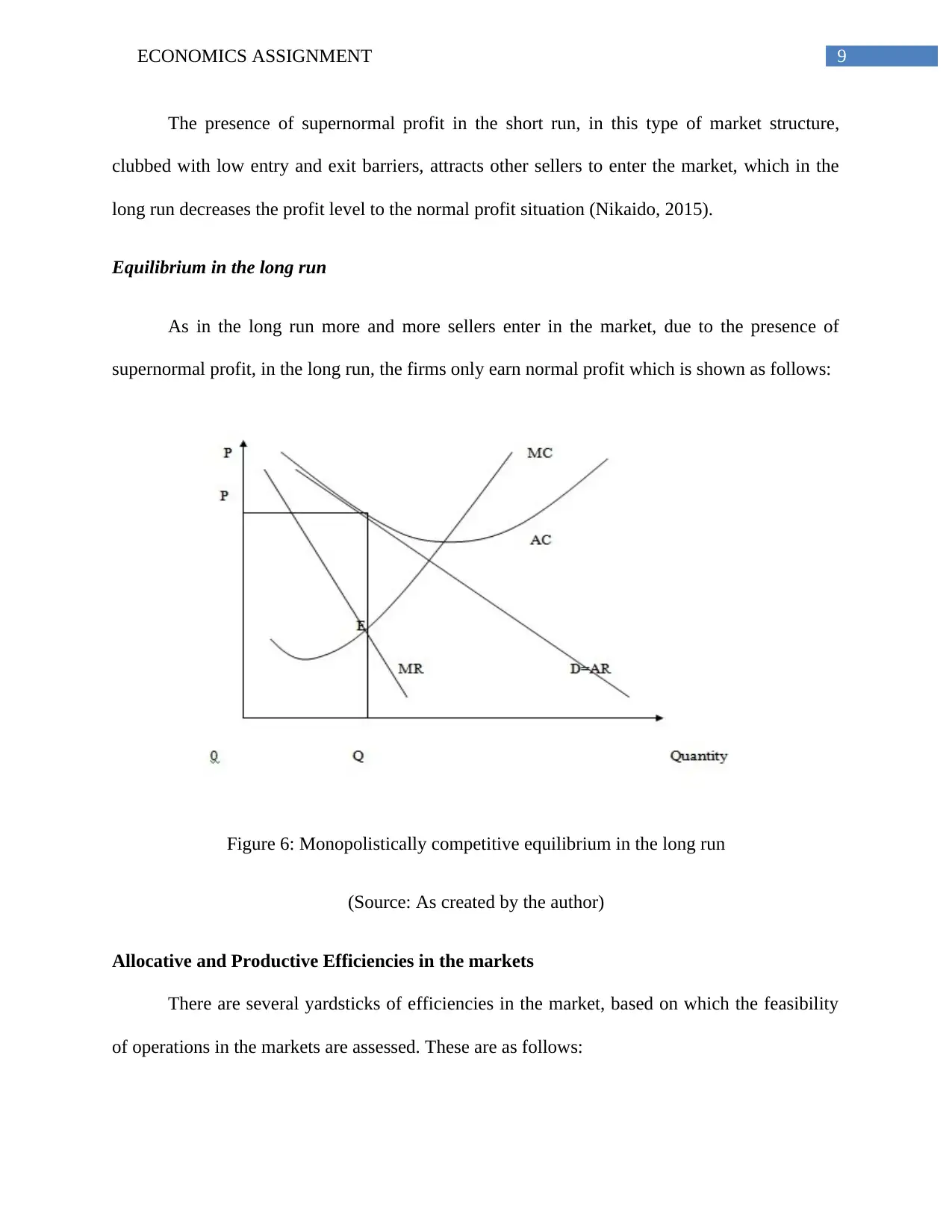
9ECONOMICS ASSIGNMENT
The presence of supernormal profit in the short run, in this type of market structure,
clubbed with low entry and exit barriers, attracts other sellers to enter the market, which in the
long run decreases the profit level to the normal profit situation (Nikaido, 2015).
Equilibrium in the long run
As in the long run more and more sellers enter in the market, due to the presence of
supernormal profit, in the long run, the firms only earn normal profit which is shown as follows:
Figure 6: Monopolistically competitive equilibrium in the long run
(Source: As created by the author)
Allocative and Productive Efficiencies in the markets
There are several yardsticks of efficiencies in the market, based on which the feasibility
of operations in the markets are assessed. These are as follows:
The presence of supernormal profit in the short run, in this type of market structure,
clubbed with low entry and exit barriers, attracts other sellers to enter the market, which in the
long run decreases the profit level to the normal profit situation (Nikaido, 2015).
Equilibrium in the long run
As in the long run more and more sellers enter in the market, due to the presence of
supernormal profit, in the long run, the firms only earn normal profit which is shown as follows:
Figure 6: Monopolistically competitive equilibrium in the long run
(Source: As created by the author)
Allocative and Productive Efficiencies in the markets
There are several yardsticks of efficiencies in the market, based on which the feasibility
of operations in the markets are assessed. These are as follows:
Paraphrase This Document
Need a fresh take? Get an instant paraphrase of this document with our AI Paraphraser
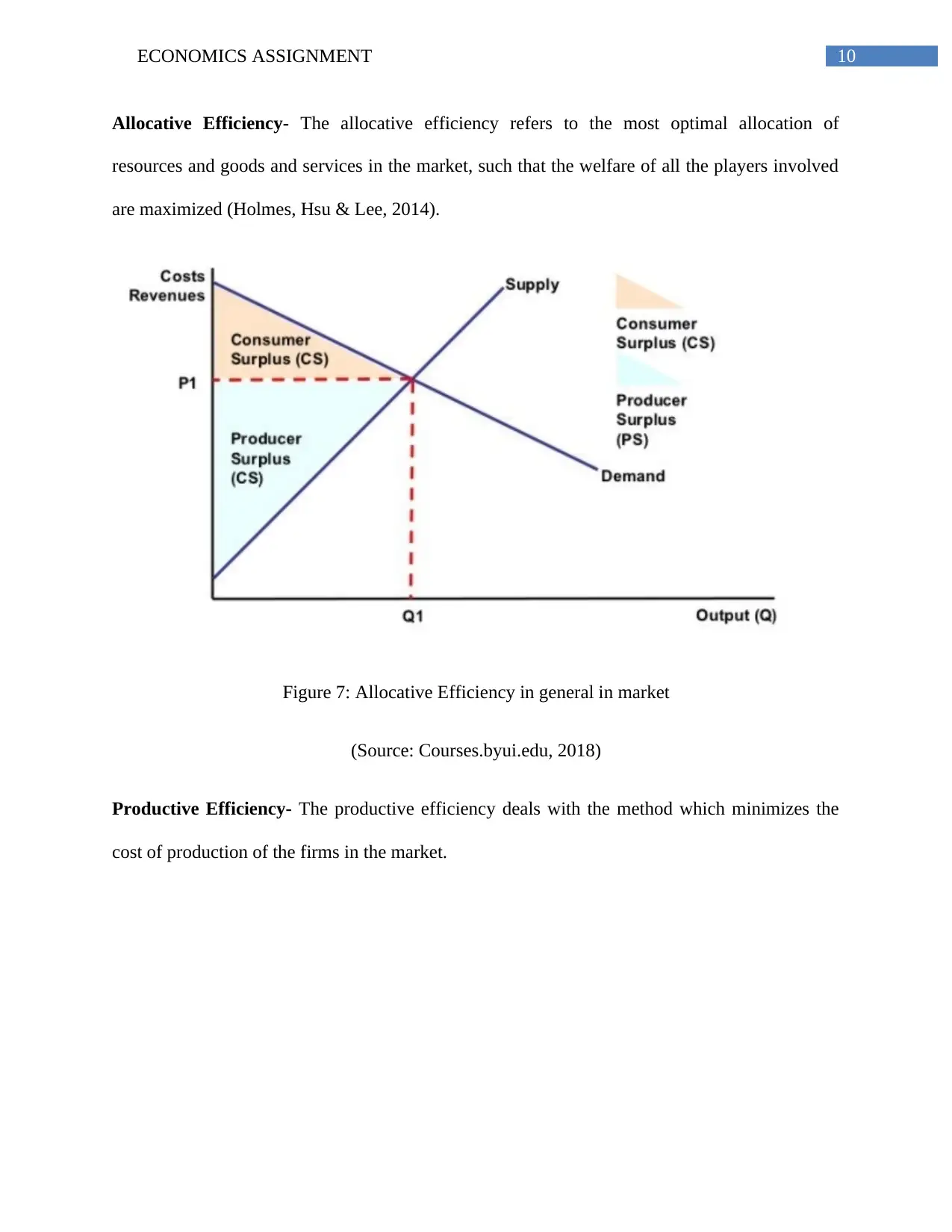
10ECONOMICS ASSIGNMENT
Allocative Efficiency- The allocative efficiency refers to the most optimal allocation of
resources and goods and services in the market, such that the welfare of all the players involved
are maximized (Holmes, Hsu & Lee, 2014).
Figure 7: Allocative Efficiency in general in market
(Source: Courses.byui.edu, 2018)
Productive Efficiency- The productive efficiency deals with the method which minimizes the
cost of production of the firms in the market.
Allocative Efficiency- The allocative efficiency refers to the most optimal allocation of
resources and goods and services in the market, such that the welfare of all the players involved
are maximized (Holmes, Hsu & Lee, 2014).
Figure 7: Allocative Efficiency in general in market
(Source: Courses.byui.edu, 2018)
Productive Efficiency- The productive efficiency deals with the method which minimizes the
cost of production of the firms in the market.
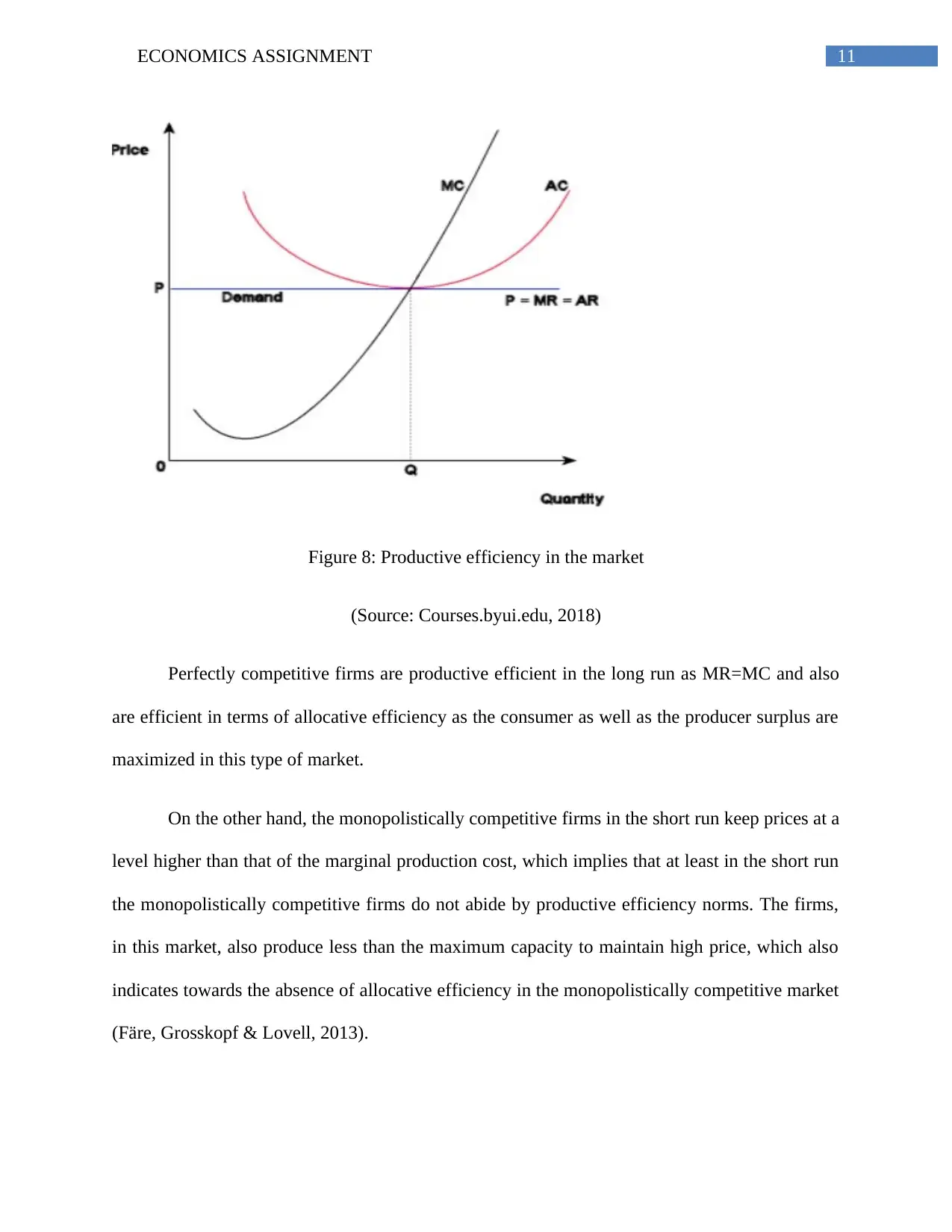
11ECONOMICS ASSIGNMENT
Figure 8: Productive efficiency in the market
(Source: Courses.byui.edu, 2018)
Perfectly competitive firms are productive efficient in the long run as MR=MC and also
are efficient in terms of allocative efficiency as the consumer as well as the producer surplus are
maximized in this type of market.
On the other hand, the monopolistically competitive firms in the short run keep prices at a
level higher than that of the marginal production cost, which implies that at least in the short run
the monopolistically competitive firms do not abide by productive efficiency norms. The firms,
in this market, also produce less than the maximum capacity to maintain high price, which also
indicates towards the absence of allocative efficiency in the monopolistically competitive market
(Färe, Grosskopf & Lovell, 2013).
Figure 8: Productive efficiency in the market
(Source: Courses.byui.edu, 2018)
Perfectly competitive firms are productive efficient in the long run as MR=MC and also
are efficient in terms of allocative efficiency as the consumer as well as the producer surplus are
maximized in this type of market.
On the other hand, the monopolistically competitive firms in the short run keep prices at a
level higher than that of the marginal production cost, which implies that at least in the short run
the monopolistically competitive firms do not abide by productive efficiency norms. The firms,
in this market, also produce less than the maximum capacity to maintain high price, which also
indicates towards the absence of allocative efficiency in the monopolistically competitive market
(Färe, Grosskopf & Lovell, 2013).
⊘ This is a preview!⊘
Do you want full access?
Subscribe today to unlock all pages.

Trusted by 1+ million students worldwide
1 out of 23
Related Documents
Your All-in-One AI-Powered Toolkit for Academic Success.
+13062052269
info@desklib.com
Available 24*7 on WhatsApp / Email
![[object Object]](/_next/static/media/star-bottom.7253800d.svg)
Unlock your academic potential
Copyright © 2020–2025 A2Z Services. All Rights Reserved. Developed and managed by ZUCOL.





